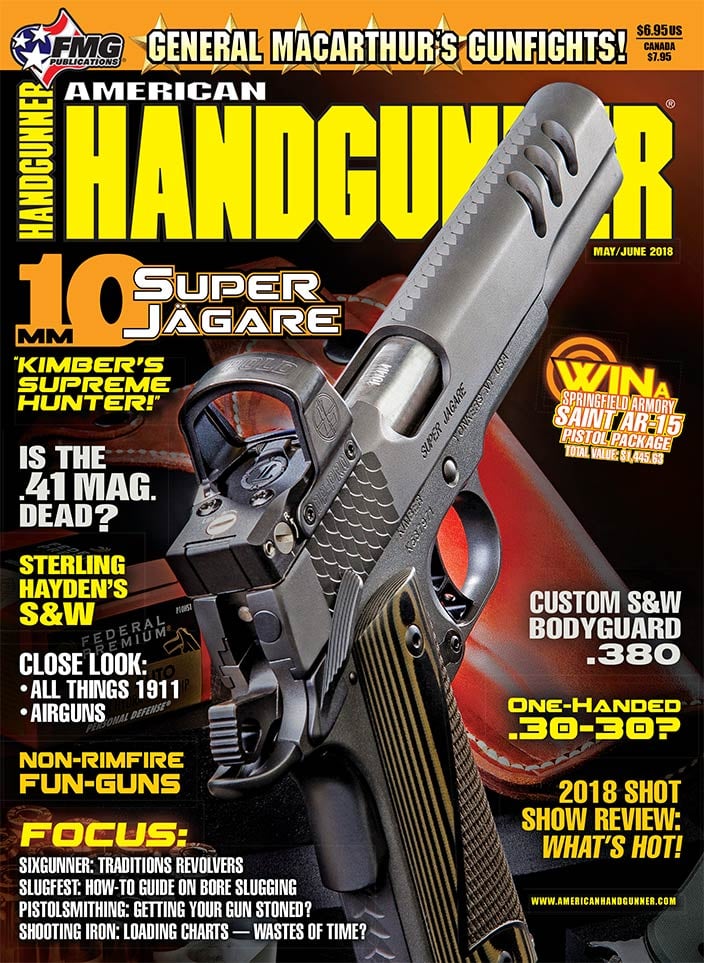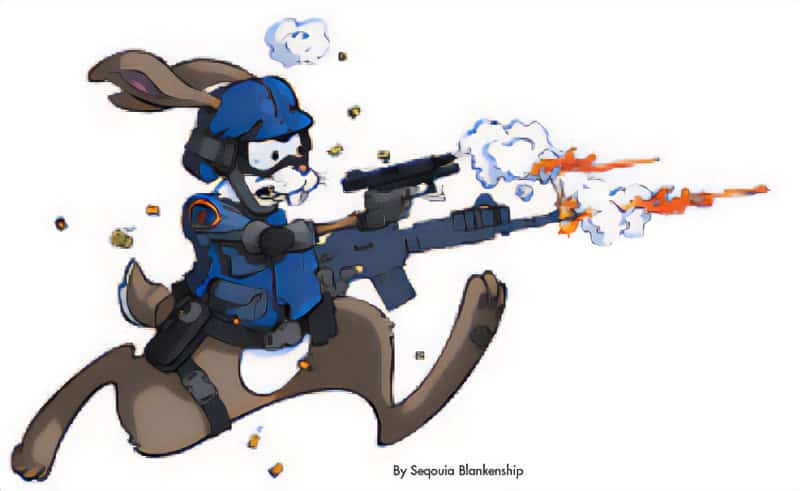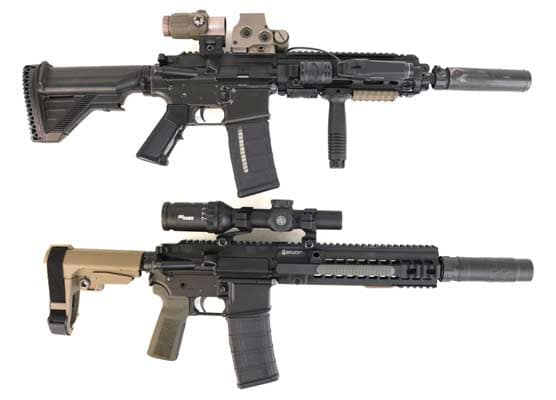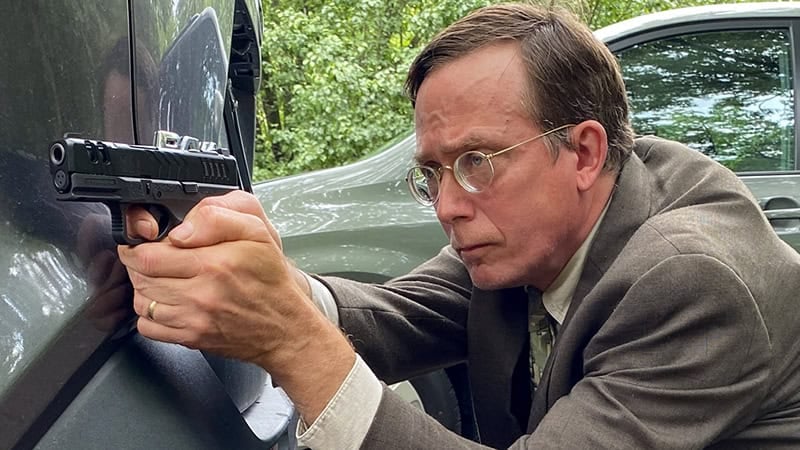The Gunfights of General Douglas MacArthur
Situation:
Derided behind his back as “Dugout Doug” for leading from behind the lines in World War II, General MacArthur “shot for blood,” sometimes against overwhelming odds.
Lesson:
Having a .38 revolver or a .45 automatic matters less than possessing courage, resolve, and skill … and some learn the hard way that leading from the rear is required to see the big picture of the battle.
My generation, the Boomers, grew up in neighborhoods where a great many of the grownup men around us had served in World War II. I noticed early most who had fought in Europe described General George Patton, Jr. as someone they would have followed through the gates of Hell, but Pacific Theater vets often sneered at General Douglas MacArthur as “Dugout Doug,” the implication being he stayed safely behind the lines.
I suspect those men had never learned General MacArthur’s true history in detail.
David Sears of American History magazine has written, “Douglas MacArthur was a paradox. He received 13 awards for bravery, including the Medal of Honor. Perhaps the most gifted battlefield soldier America ever produced, he orchestrated remarkable victories in France, New Guinea, the Philippines and Korea while economizing on casualties. As viceroy of Japan, he bestowed forgiveness and introduced Dai Nippon to civil liberties and equal rights for women. Yet MacArthur’s heroics, displays of principle and magnetic aura were inevitably offset by pettiness, paranoia and appalling vindictiveness. In short, wrote biographer William Manchester, ‘No more baffling, exasperating soldier ever wore a uniform.’”
First Armed Encounter
MacArthur graduated first in his class at West Point, the academy he would later command. It was as a newly minted shavetail assigned to a base in San Francisco, CA, where he first faced an armed opponent alone. In his autobiography Reminiscences (Blue Jacket Books/Naval Institute Press, 1964), MacArthur wrote:
“A prisoner engaged in work at Fort Mason, where we lived, had escaped. He was a burly fellow armed with a scythe, and great consternation reigned in the post and the adjacent homes on Van Ness Avenue. Search parties were organized throughout the neighborhood, and women and children warned to stay indoors. The fort is situated on a high bluff sloping down to the harbor line. The slope was rough and covered with tangled underbrush. It was none of my business, but I had tracked trails too often with the Apaches not to pick up this one. His hiding place was easy to locate, and I had him covered before he had a chance to make a move. When I turned him over to the guard, he just spat at me and snarled, ‘You damn West Pointers!’”
First Gunfight
He was still a lieutenant when, in the Philippines, he first had to shoot an opponent. In his autobiography, MacArthur wrote, “While attempting to construct piers and docks at Guimaras Island, located at the mouth of Iloilo Harbor, I had to procure my own piling, and took a small detachment to cut timber in the jungle forests. The place was dangerous, being infested with brigands and guerrillas. In spite of my early frontier training, I became careless and allowed myself to be waylaid on a narrow jungle trail by two of these desperadoes, one on each side. Like all frontiersmen, I was expert with a pistol. I dropped them both dead in their tracks, but not before one had blazed away at me with his antiquated rifle. The slug tore through the top of my campaign hat and almost cut the sapling tree immediately behind me.
“My foreman, a Regular Army sergeant and veteran of long years of service, came rushing up. He looked long and hard at the two dead men sprawled on the trail, at my crownless hat still smoking from the blast, at the broken tree behind me. And then, rolling his quid of tobacco into the hollow of his cheek, he slowly drew himself up to his full six feet of height, his heels clicking together, saluted, and drawled in his rich Irish brogue, ‘Begging the Loo’tenant’s paddon, but all the rest of the Loo’tenant’s life is pure velvut.” (Note to readers: the spelling is MacArthur’s, not mine.)
Outnumbered and outgunned, the young MacArthur had slain both of his opponents with a .38 caliber revolver. None of the histories I’ve found go into any more detail on his weapon, but the standard issue sidearm during the first decade of the 20th century was the double-action Colt 1892 Army and Navy Model, chambered for .38 Long Colt and generally issued with a 6″ barrel. It was a fragile, almost rickety thing compared to the Colt Army Special supplanting it in the Colt catalog circa 1908, but if that is indeed what he used, MacArthur was not the only American who was well served by it.
Theodore Roosevelt had wielded such a revolver when he led the charge up San Juan Hill in the Spanish-American war a few years before MacArthur’s incident, and used it to kill at least one enemy soldier with a single body shot. Having killed men with it was not the only thing those two great men had in common: Genealogists say Roosevelt and MacArthur were 16th cousins, twice removed. MacArthur served for a time as aide-de-camp to then-President Theodore Roosevelt beginning in December 1906.
MacArthur, after winning the Pacific Campaign and becoming the military governor of post-war Japan, would say in his autobiography: “I greatly admired Theodore Roosevelt. His prophetic vision of Asian politics marked him as a statesman of brilliant imagination.”
Next Gunfight (Or Three)
MacArthur’s next “shoot to live” experience occurred in Mexico, when he was attempting to scout out enemy rail capability during the Veracruz Expedition. By then he was a captain, and had been issued the 1911 .45 Auto the US military had adopted in the eponymous year. Historian David Sears describes the incident, and what led up to it, thus: “After crossing on foot unseen through American lines, MacArthur found the Mexican engineer at a siding, waiting with the handcar. Over the man’s objections, MacArthur patted him down, confiscating a .38 and a dagger. MacArthur then allowed the engineer to frisk him, to telegraph the Mexican would be getting his $150 in gold only after they returned — if they returned.
“Their handcar, sometimes called a ‘pump trolley,’ was powered by a seesaw-like ‘walking beam.’ Rhythmically pushing down and pulling up on the beam, the two sped along the Tehuantepec line as far as the Jamapa River, where the rail bridge was down. On the bank, they found a small canoe in which they crossed the Jamapa. At the far shore, they stole two ponies and trotted them alongside the Tehuantepec line. Skirting Paso del Toro, the pair found the railroad workers with the promised narrow-gauge handcar waiting on the Alvarado rails. MacArthur searched his new conspirators, finding no weapons. Hiding the stolen ponies, the four pumped toward Alvarado.
“Small bridges and culverts dotted the line. At the first structure, the Mexicans stopped to check it, prompting MacArthur to draw his .45 as a prod. ‘After getting into the spirit of the thing,’ MacArthur wrote in his account to Wood, ‘their conduct was most admirable.’
“Still, MacArthur was taking no chances. At each town he tied himself to one man and sent the other two through on the handcar while he and his ‘companion’ circled the village and rejoined the party on the far side. ‘This took time,’ MacArthur admitted later, ‘but was the only way I could avoid detection.’
“Making Alvarado shortly after 1 a.m., MacArthur almost immediately found what he sought: five railroad engines. Two were yard switch engines, ‘worthless for our purpose,’ but three were ‘fine big road pullers,’ he wrote later. Quickly inspecting the locomotives, MacArthur climbed aboard the handcar for the 42-mile run to Veracruz — and a host of troubles.
“The pre-dawn return ride was uneventful as far as Salinas, where, as before, MacArthur and a tethered companion set out to edge around the coastal town. Five armed men confronted them — in MacArthur’s words, ‘one of the marauding bands that infest the country with brigandage as a trade.’
“The American and his companion ran for it, outdistancing three pursuers but not the other two, who cornered them. Shots might alert Mexican soldiers and panic the men with the other handcar, but MacArthur had no choice. He stopped, aimed, and fired his .45 automatic. Both assailants went down.
“On the handcar, now traveling through a blinding mist, the shaken quartet pushed on to Piedra, where 15 armed horsemen surrounded them. ‘We were among them before I realized it and were immediately the center of a melee,’ MacArthur said later. The engineer stopped a slug with his shoulder. Three rounds passed through MacArthur’s clothes without striking flesh. Riders knocked him from the handcar. Regaining his feet, the captain fired, taking down four foes at close range. The others fled. After reloading his .45 and patching up the wounded man, MacArthur led his squad — bloodied, exhausted and rattled — north ‘with all possible speed.’
“Near Laguna, halfway to Paso del Toro, the men encountered three mounted pistoleros. A running gunfight ensued, with the handcar rolling hard and riders trying to keep up. Remarkably, the car, occupants laboring like human pistons, outdistanced two horsemen. But the third, ‘unusually well mounted’ in MacArthur’s estimation, ‘overhauled and passed the car.’ After taking another bullet through his shirt and having rounds twice ricochet inches away, MacArthur ‘felt obliged to bring him down.’ The man fell — as did his mount, sprawling dead across the tracks ahead. It took all four men to drag the carcass and corpse out of their way.”
The incident had degenerated into three separate gunfights, all of which MacArthur decisively won, in all but one of which he was outnumbered. In those three consecutive shootouts in Mexico, MacArthur shot down seven men. For perspective, shooting seven enemy soldiers a few years later during World War I was a part of the heroism that won Alvin York the Medal of Honor.
General Leonard Wood actually nominated MacArthur for the Medal of Honor for the incident in Mexico. It was turned down. The reason: His expedition to check out the locomotives had not been approved beforehand by his commanding general.
Trenches & No Man’s Land
MacArthur had made major by the time World War I started, and colonel by the time he set foot in Europe. He immediately distinguished himself as an officer who led from the front. In his autobiography, he wrote:
“On February 26 (1918) I had my first contact with German troops. I had long felt it was imperative to know by personal observation what the division had to face. It is all very well to make a perfect plan of attack, to work out in theory a foolproof design for victory. But if the plan does not consider the caliber of troops, the terrain to be fought over, the enemy strength opposed, then it may become confused and fail. I went to see General de Bazelaire, but he was reluctant to authorize me to join a French raiding party out to capture Boche prisoners. I told him frankly, ‘I cannot fight them if I cannot see them.’ He understood, and told me to go.
“It was an overcast night, but the poilus’ faces were daubed with black so the faint light would not gleam on their white features. Carrying pliers to cut the enemy wire, they crawled through the barbed wire and over the bleak piles of war refuse lying between the German and the Allied trenches. Just short of the trench they intended to raid, a German guard heard them. His gun flashed in the night. The alarm spread through the trench, across the front. Flares soared and machine guns rattled. Enemy artillery lay down a barrage in front of the lines, trapping the party. But the raid went on. They leaped into the trenches, and the fight was savage and merciless. Finally, a grenade, tossed into a dugout where the surviving Germans had fled, ended it. When we returned with our prisoners those veteran Frenchmen crowded around me, shaking my hand, slapping me on the back, and offering me cognac and absinthe. I was probably the first American soldier they had seen. General de Bazelaiare pinned a Croix de Guerre on my tunic and kissed me on both cheeks. I was now one of them. For this small but savage action near Rechicourt, the American command awarded me the Silver Star, for ‘extraordinary heroism and gallantry in action.’ The award seemed a bit too much to me, but I was, of course, glad to have it.”
This Silver Star was the first of six Douglas MacArthur would earn in World War I, for his personal courage and action under fire. Here is his own account, from his autobiography, of another engagement during the Great War:
“’All ready, Casey?’ I yelled into the ear of ‘F’ Company’s battalion commander, Captain Charles J. Casey. ‘Okay, Colonel,’ he said, and the whistles blew. ‘Up you go,’ I heard his ringing voice. ‘Keep alignment. Guide is right. Don’t rush or you’ll get your own barrage on your neck.’
“I went over the top as fast as I could and scrambled forward. The blast was like a fiery furnace. For a dozen terrible seconds I felt they were not following me. But then, without turning around, I knew how wrong I was to have doubted for even an instant. In a moment, they were around me, ahead of me, a roaring avalanche of glittering steel and cursing men. We carried the enemy position.
“From then on (our Rainbow Division) was rated by both friend and foe as a fighting ace. Major Casey and I were awarded the Distinguished Service Cross, second only to the Medal of Honor as a battle decoration.”
The Medal Of Honor
In 1942, Douglas MacArthur finally did receive the Medal of Honor. The official citation reads, The President of the United States of America, in the name of Congress, takes pleasure in presenting the Medal of Honor to General of the Army Douglas MacArthur (ASN: 0-57), United States Army, for conspicuous leadership in preparing the Philippine Islands to resist conquest, for gallantry and intrepidity above and beyond the call of duty in action against invading Japanese forces, and for the heroic conduct of defensive and offensive operations on the Bataan Peninsula. General MacArthur mobilized, trained, and led an army which has received world acclaim for its gallant defense against a tremendous superiority of enemy forces in men and arms. His utter disregard of personal danger under heavy fire and aerial bombardment, his calm judgment in each crisis, inspired his troops, galvanized the spirit of resistance of the Filipino people, and confirmed the faith of the American people in their Armed Forces.
“Dugout Doug”?
Why, then, was he given the ugly sobriquet “Dugout Doug”? Some saw him as having abandoned the Philippines, and particularly Bataan and Corregidor, at the opening of World War II. The fact is, he did so reluctantly and only upon insistent, direct orders from Washington; from Franklin D. Roosevelt on down, his superiors knew defense of the area at that time against overwhelming Japanese forces was utterly hopeless, and MacArthur was a brilliant general the United States could not afford to sacrifice. His history in the Pacific Campaign, culminating with his acceptance of Japan’s surrender and his role as what some biographers called “the American Emperor” of postwar Japan proved the wisdom of those orders.
Even during WWI, legend has it MacArthur got his knuckles severely rapped by his superiors for leading from the front as a colonel charging across “no man’s land” into the gunfire from enemy trenches. A commander had to stay behind the front line, he was told, to see the big picture in perspective and guide his troops appropriately within the totality of what was happening at the battlefront. It was a principle MacArthur eventually adopted, if grudgingly, but even during World War II he found himself occasionally reverting to his World War I persona. During the recovery of the Philippines, he was known to visit the front and expose himself to enemy fire, much to the horror of his retinue.
“Dugout Doug”? Not hardly.
Gunfight Lessons
In the course of those pre-World War I encounters, Douglas MacArthur put a total of nine opponents horizontal with his handguns. By all accounts he was a brave man, and one who could stay focused on doing what had to be done. He claimed he learned to ride horses and shoot guns as a little boy before he learned to read. Having learned to shoot well early is a thread running through the history of American heroes in combat: Alvin York in World War I, Audie Murphy in World War II, Carlos Hathcock in Vietnam, Chris Kyle in the current conflict … the list goes on, forward and back.
It would appear this early grounding from his father, a Civil War combat hero himself and also a Medal of Honor winner, served him well.
Perhaps the final lesson is there’s a time to lead from the front, and a time to lead from the rear, where there is likely to be wider perspective.
In his famous departure speech, General Douglas MacArthur said, as an old soldier, he would just fade away. Let us hope instead the lessons of his victories — in face-to-face combat, as well as his campaigns in global conflict — never fade away.




